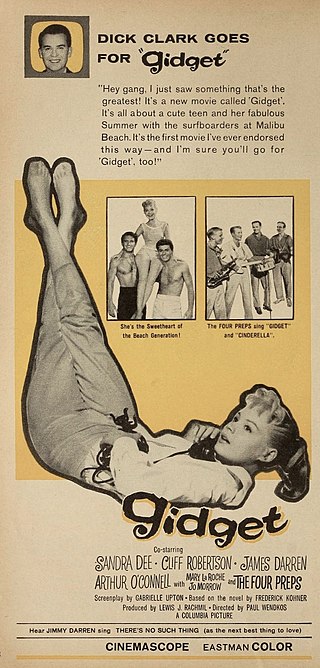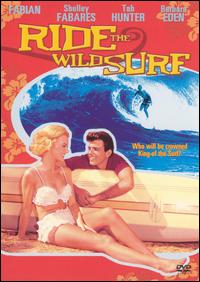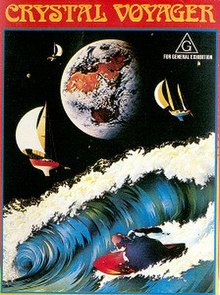
Obscured by Clouds is the seventh studio album by the English progressive rock band Pink Floyd, released on 2 June 1972 by Harvest and Capitol Records. It serves as the soundtrack for the French film La Vallée, by Barbet Schroeder. It was recorded in two sessions in France, while Pink Floyd were in the midst of touring, and produced by the band.
"Echoes" is a song by the rock band Pink Floyd, and the sixth and last track on their 1971 album Meddle. It is 23 and a half minutes long and takes up the entire second side of the original LP. The track evolved from a variety of different musical themes and ideas, including instrumental passages and studio effects, resulting in the side-long piece. The music was written by the group, while Roger Waters' lyrics addressed themes of human communication and empathy, which he returned to in later work.
Kneeboarding is a discipline of surfing where the rider paddles on his or her belly into a wave on a kneeboard, then rides the wave face typically on both knees. The typical kneeboard is between 150 and 200 cm in length, with a wide round nose and constructed of Glassfibre over a polyurethane foam core. Kneeboard designers however are known for their wild experimental excess and so most modern materials including various aerospace elements such as Titanium alloys, carbon fibre and kevlar in epoxy matrices are not unusual. Modern kneeboards may have a rubber pad for the rider's knees, preventing undue wear of the knees, also preventing slipping to help the rider maintain control. Kneeboarders also typically use swimfins and an ankle surfleash.

Pink Floyd: Live at Pompeii is a 1972 concert film directed by Adrian Maben and featuring the English rock group Pink Floyd performing at the ancient Roman amphitheatre in Pompeii, Italy. The band performs a typical live set from the era, but there is no audience beyond the basic film crew. The main footage in and around the amphitheatre was filmed over four days in October 1971, using the band's regular touring equipment, including a mobile 8-track recorder from Paris. Additional footage filmed in a Paris television studio the following December was added for the original 1972 release. The film was then re-released in 1974 with additional studio material of the band working on The Dark Side of the Moon, and interviews at Abbey Road Studios.

Dogtown and Z-Boys is a 2001 documentary film produced by Agi Orsi and directed by Stacy Peralta. The documentary explores the pioneering of the Zephyr skateboard team in the 1970s and the evolving sport of skateboarding. Using a mix of film of the Zephyr skateboard team (Z-Boys) shot in the 1970s by Craig Stecyk, along with contemporary interviews, the documentary tells the story of a group of teenage surfer/skateboarders and their influence on the history of skateboarding culture.

George Hamilton Perkins Greenough is an influential surfer, known during the 1960s and 1970s for his work in film, and in surfboard design, fin characteristics, and other creations for the aquatic medium. The contributions of Greenough, along with Bob McTavish, to the development of short boards resulted in a number advances in surfboard shaping and other surfing technology.

Blackrock is a 1997 Australian teen drama thriller film produced by David Elfick and Catherine Knapman, directed by Steven Vidler with the screenplay by Nick Enright. Marking Vidler's directorial debut, the film was adapted from the play of the same name, also written by Enright, which was inspired by the murder of Leigh Leigh. The film stars Laurence Breuls, Simon Lyndon and Linda Cropper, and also features the first credited film performance of Heath Ledger. The film follows Jared (Breuls), a young surfer who witnesses his friends raping a girl. When she is found murdered the next day, Jared is torn between revealing what he saw and protecting his friends.

Pink Floyd – The Wall is a 1982 British musical drama film directed by Alan Parker, based on Pink Floyd's 1979 album The Wall. The screenplay was written by Pink Floyd vocalist and bassist Roger Waters. The Boomtown Rats vocalist Bob Geldof plays rock star Pink, who, driven to insanity by the pressures of stardom and traumatic events in his life, constructs a physical and emotional wall to protect himself. However, this coping mechanism eventually backfires, and Pink demands to be set free.

Surf movies fall into three distinct genres:

"Careful with That Axe, Eugene" is an instrumental piece by the English rock band Pink Floyd. It was recorded in November 1968 and released as the B-side to the single "Point Me at the Sky", and featured on the 1971 compilation album Relics. It was re-recorded for the 1970 film Zabriskie Point, retitled as "Come In Number 51, Your Time Is Up".

"Us and Them" is a song by the English progressive rock band Pink Floyd, from their 1973 album The Dark Side of the Moon. The music was written by Richard Wright with lyrics by Roger Waters. It is sung by David Gilmour, with harmonies by Wright. The song is 7 minutes and 49 seconds, the longest on the album.

Pink Floyd was considered a pioneer in the live music experience for combining intense visual experiences with music to create a show in which the performers themselves were almost secondary. As well as visuals, Pink Floyd set standards in sound quality with innovative use of sound effects and panning quadrophonic speaker systems.
Tracks is a monthly Australian surf magazine, promoting itself as "the surfers' bible." It is published by Nextmedia.
Albert "Alby" Falzon is an Australian filmmaker, photographer and publisher in the surfing sub-culture.
Morning of the Earth is a 1971 classic surf film by Alby Falzon and David Elfick.
Captain Goodvibes, a.k.a. the Pig of Steel, is the creation of Australian cartoonist Tony Edwards and an icon of Australian surfing culture from the 1970s. In 1992 Captain Goodvibes was named by Australia's Surfing Life magazine as one of "Australia's 50 Most Influential Surfers." The character was inspired by American cartoonist Gilbert Shelton's underground comix character, Wonder Wart-Hog, a.k.a. the "Hog of Steel."
Robert Harold "Nat" Young is an Australian surfer and author.

Thicker Than Water is a 2000 documentary surf film directed by singer/songwriter Jack Johnson and his film school friend Chris Malloy. It shows surfing footage from different locations like Australia, Indonesia, Hawaii, India, and Ireland in combination with a wide range of styles of guitar music. Surfers in the film include Kelly Slater and Shane Dorian.
David Elfick is an Australian film and television writer, director, producer and occasional actor. He is known for his association with writer-director Phillip Noyce, with whom he has collaborated on films including Newsfront (1978) and Rabbit-Proof Fence (2002).

Ride the Wild Surf is a 1964 American romantic drama film. It was filmed in 1963 and distributed in 1964. Unlike the beach party movies of the era, this was a departure from the typical Hollywood approach to surfing as it was a drama, not a comedy. It is known for its exceptional big wave surf footage – a common sight in surf movies of the time, but a rarity in Hollywood films. Likewise, the film has only one pop song – the titular Jan and Dean track, which is heard once, at the end of the film.












